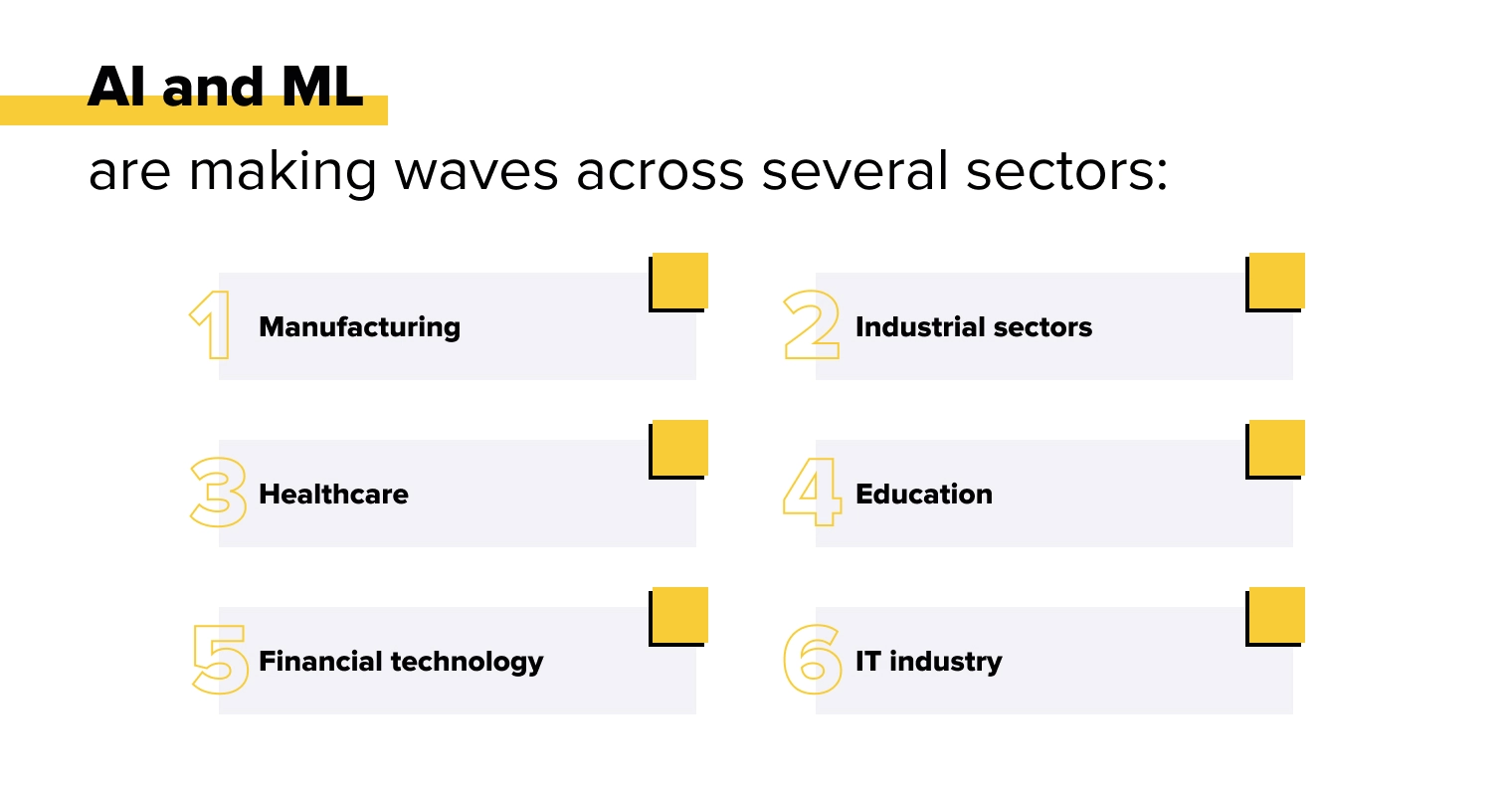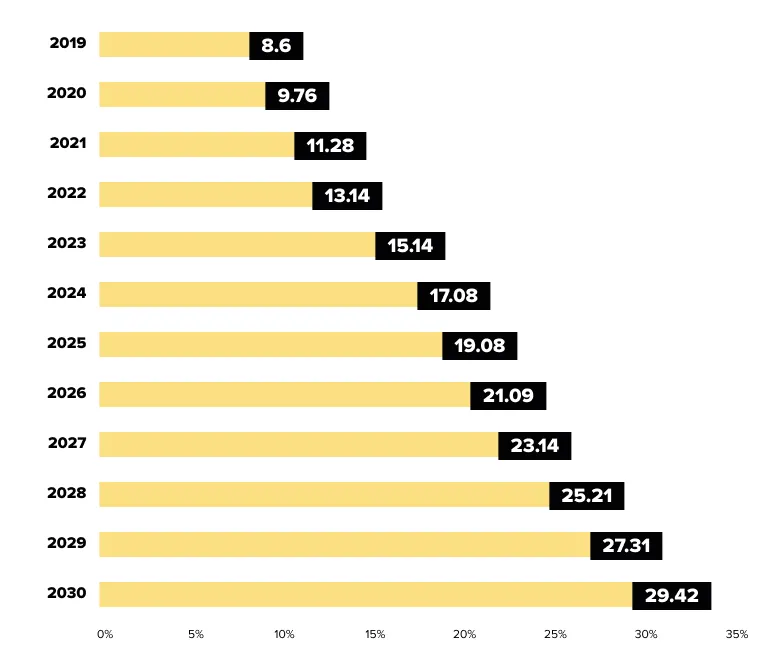Emerging technologies are delving deeper into every industry, aiming to simplify tasks and forge new development paths. According to Fortune Business Insights, the digital transformation market was valued at $1.91 trillion in 2022. It's projected to reach $2.27 trillion in 2023 and surge to $8.92 trillion by 2030.
This rapid market growth is fueled by the widespread integration of cutting-edge technologies across large enterprises, small businesses, and medium-sized ventures. Among the innovative trends are artificial intelligence, cloud computing, blockchain technology, big data, DevOps, and more. All these innovations are designed to streamline operations, expedite business processes, and optimize development process. Experts at Lampa have extensively studied the popular trends in the digital transformation market and are excited to present a list of the latest technologies in the software industry, including AI app development.
Artificial Intelligence and Machine Learning
As highlighted by IBM's research, 35% of companies actively employ artificial intelligence (AI), while 42% implement this technology. AI replicates human behavior to perform various routine tasks, and machine learning (ML), a subset of AI, aids in learning and adapting to new information. These AI-based technologies optimize enterprise operations and free up specialists' time for tackling more intricate challenges.
AI and ML are making waves across several sectors:

In the realm of software development, AI enhances efficiency and team productivity. It simplifies tasks by conducting static code analysis, automating testing, executing assigned assignments, generating design ideas, devising market promotion strategies, and more.
Furthermore, AI finds application in data science, which is crucial for extracting and processing valuable business information. Thanks to specific algorithms and machine learning, computers recognize necessary data for collection, structure it, and aid in analysis.
Artificial intelligence and machine learning are trending software technologies in 2023. Integrating it into digital products offers numerous advantages, including:
Data analysis for decision-making using neural networks.
Personalizing products based on user requirements.
High-level security and protection against malware.
Image and speech recognition to expand product functionality.
Creating chatbots and other assistants to enhance the customer experience.
All of these factors contribute to creating competitive programs known for their performance, reliability, and security.
Internet of Things (IoT) and Edge Computing
Internet of Things (IoT) is a system of physical devices interconnected to collect and share data wirelessly without human intervention. The number of devices connected to the IoT keeps growing, and experts predict this trend will continue.

(Number of active IoT devices, according to Statista)
Among the latest trends in Internet of Things technology, we find edge computing, which involves data processing closer to where it's generated. This approach ensures swift handling of large data volumes and provides reliable real-time results.
As a new software technology, IoT with edge computing offers the following advantages:
Reducing the time required for processing massive data sets.
Optimizing Internet of Things apps to deliver real-time data.
Improved processing and filtering of data collected by devices.
Enhanced security through storing information on local edge servers
Furthermore, such equipment simplifies our lives and aids in professional activities. Here are a few examples of real IoT devices:
Google Home Voice Controller: A smart device that allows you to control various systems in your home (alarm, TV, lighting, etc.) using voice commands.
Amazon Echo Plus: Another voice controller that can initiate phone calls, manage to-do lists, set reminders, and much more.
Philips Hue Go: A smart portable light that lets you customize your lighting setup.
Footbot Air Quality Monitor: A device for tracking air pollution levels at home or in the workplace, with air purification and temperature regulation features.
Blockchain Technology
Until recently, blockchain technology was strongly associated solely with cryptocurrencies. However, it has now extended far beyond the fintech industry and become the latest technology in the software industry. According to a survey by CasperLabs and Zogby Analytics, around 87% of surveyed companies plan to invest in blockchain solutions in the near future.
Blockchain is a decentralized system where records of various operations are organized in a block structure.
Notably, the data in a blockchain is publicly available, and it's impossible to delete, alter, or edit them from the chain. This ensures that the system can automatically verify the accuracy of recorded information. Such transparency helps businesses establish a reliable reputation, build customer trust, and enhance loyalty.
Thanks to decentralized data storage, blockchain technology:
Enhances the security of developed digital products.
Ensures transparency in the operation of apps and software.
Boosts user trust in new software systems.
Prevents unauthorized access and other fraudulent actions.
These advantages in cybersecurity have positioned blockchain prominently in the development industry. Various apps and programs are built on this newest software technology. For example, supply chain tracking systems, resources for protecting copyright and intellectual property rights, secure voting systems, and more.
Augmented Reality (AR) and Virtual Reality (VR)
Augmented and virtual reality interact with the physical world through specialized devices. These technologies gained significant popularity during the Covid-19 pandemic as consumers began to make online purchases en masse. Virtual workspaces for remote employees also emerged. One such platform, Horizon Workrooms, was launched by Meta (formerly Facebook) in 2021.
Cross-platform development of apps with AR or VR features is especially popular in areas such as:
Entertainment and gaming (virtual travel programs, VR games).
Online shopping (apps that allow trying on clothes virtually).
Creative fields (digital workspaces for artists).
Healthcare (3D data apps for surgical planning and procedures).
Everyday solutions (visual repair guides).
Education (apps for learning subjects by visual virtual example).
As the latest technologies in software industry, virtual and augmented spaces help create products that offer customers a new user experience. Leveraging the capabilities of AR and VR, you can provide custom software that delivers:
Full or partial immersion in the digital world.
Comprehensive presentation of services or products.
Modernized user interfaces for interacting with physically unavailable items.
Improved internal remote business processes
Frontend development of various IT products with virtual reality components offers a fully immersive digital environment. This latest software technology provides users with a unique experience, increasing their interest in the program and strengthening their engagement with your business.
Progressive Web Applications (PWAs)
Progressive Web Applications (PWAs) fall under web development and are essentially regular websites that also function as smartphone apps. According to data from Forbes, such web solutions have an average bounce rate of 42.86% lower than similar mobile versions of websites. Brands using PWAs also report an increase in page views by up to 134%.
Aside from the convenience PWAs offer users, they're gaining popularity among business leaders due to a combination of advantages:
Low development process costs.
High response speed.
Compatibility with push notifications.
Availability of offline mode.
Ease of technical maintenance.
Unlike traditional web and mobile apps, PWAs can function on any device regardless of the operating system. Operating like a website, you can install it on the phone or computer's desktop and perform its functions seamlessly. Using this latest technology in the software industry, you don't have to develop multiple products for different devices and OSs.
Cross-platform development of these digital solutions is quite effective and financially viable. Consequently, more startups and small businesses focus on creating progressive web applications. Notable examples include:
Starbucks: The app serves as a menu and assists in offline order customization for food and beverages.
MakeMyTrip: A popular booking program known for its simplicity, reliability, and speedy request processing.
Uber: This PWA for ride-hailing offers all necessary features and functions smoothly, even with 2G coverage.
Spotify: Alongside variations for mobile platforms, the company has apps for desktop devices with different OSs, and the new "Spotify Connect" feature enables listening to music from a broader range of entertainment sources.
By combining the functionalities of mobile apps and websites, PWAs enhance user engagement and offer new ways for business promotion. Thus, this digital solution holds a prominent place among the current trends in the latest software technologies.
Low-Code and No-Code Development
Low-code and No-code (LCNC) development platforms have been specifically designed for individuals without coding skills or minimal technical knowledge. Programming languages used to create visual environments include PHP, Python, and Java.
LCNC platforms work by providing a visual interface and pre-built components. Users can monitor interactions and design their programs by dragging and dropping software components into the workspace and connecting them. This ensures ease in creating, testing, and deploying simple apps. Additionally, these latest software technologies help alleviate the workload for developers when creating basic digital products, freeing up time for more complex and large-scale projects.
According to Gartner's forecasts, the global market for Low-Code and No-Code technologies is projected to reach $26.9 billion in 2023, a 19.6% increase compared to 2022. Valuable advantages for both businesses and developers drive the active development of this software development direction:
Rapid development process and product release.
A plethora of settings for creating software across various business domains.
Seamless and fast integration with third-party services.
Availability for deploying cloud-native software.
Effective management of developer teams.
Smooth adaptation and efficiency during transitioning from traditional to emerging software technologies.
DevOps and Continuous Integration/Continuous Delivery (CI/CD)
DevOps (Development & Operations) is a methodology that revolves around merging the development and operational teams while working on various digital products. This approach fosters continuous communication among all team members, expediting task resolution and identifying and rectifying issues or glitches.
According to an Atlassian survey, 99% of respondents confirmed that implementing DevOps practices has positively impacted the entire enterprise. Through collaborative efforts, teams become more productive and save time by eliminating the need to wait for responses from other departments.
One of the DevOps practices is Continuous Integration and Continuous Delivery (CI/CD). This method involves implementing automated tools that ensure constant delivery of product components at different development stages. CI/CD also encompasses the concept of continuous deployment, where automated code testing tools are used during the program's launch. This guarantees high security, reliability, and quality for future software.
For instance, applying DevOps practices in backend and frontend development aids in creating, testing, and refining architectural and design solutions. This results in a highly user-friendly user interface and offers your clients an enhanced user experience.
New software technologies, like DevOps and its CI/CD practice, find extensive use in the development industry and business, as they:
Shorten the software development lifecycle.
Optimize development, testing, and deployment processes.
Expedite product launch into the market.
Ensure high reliability and security of software.
Reduce the risk of post-release program errors.
Accelerate the release of updates and the introduction of new features to the product.
All these benefits and more, achieved through collaborative work between developers and operational teams, help create reliable digital solutions quickly, enhancing business productivity and profitability.
Conclusion
Predicting an exhaustive list of future software technologies is quite challenging, as information technology is always evolving and expanding its repertoire with new development directions. However, we can be certain that in the coming years, blockchain technology, artificial intelligence with machine learning, cloud technologies, IoT, Low-Code and No-Code platforms, DevOps practices, PWAs, and more will remain in trend.
Looking to create a digital product using innovative methods and tools? The experts at Lampa Software are ready to assist you and suggest the most optimal solutions for bringing your ideas to life.